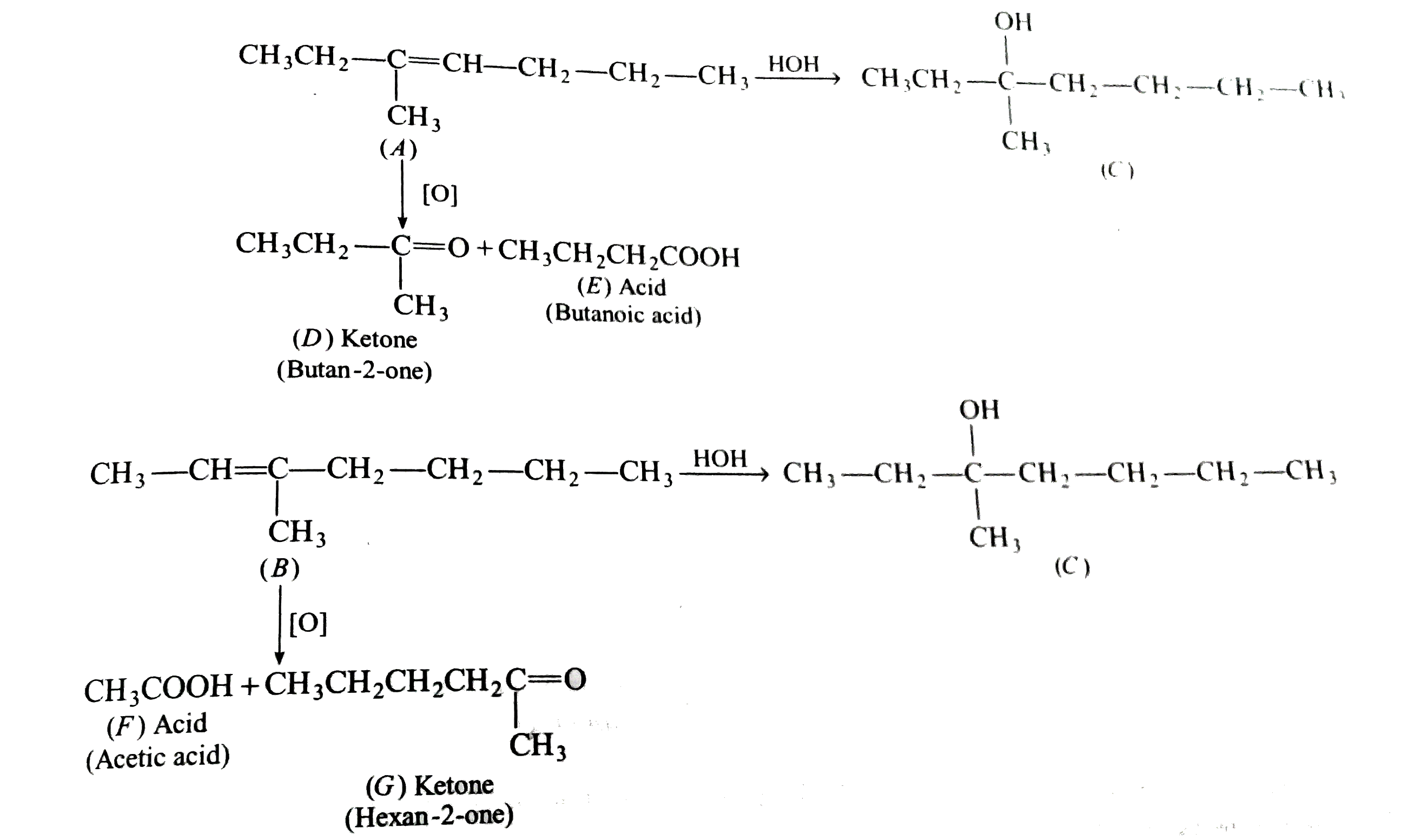Alkene (A) and (B) yield the same alcohol (C) on hydration. On vigorous oxidation with KMnO4, (A) gives a carbonyl compound (D) and an acid (E) each containing four carbon atoms. On the other hand (B) gives an aicd (F) and a carbonyl compound (G), In (G), no two identical groups are attached to the same carbon atom. Give structures of (A) to (G) with proper resoning.
Akene (A) on oxidation gives a carbonyl compound (D) and an acid (E). Each having for carbon atoms. Thus, the probable structure of (A) may be,
CH3−CH2C∣CH3=CH−CH2−CH3 or CH3−CH2−C∣CH3=CH−C∣CH3H−CH3.
Alkene (B) gives an acid (F) and a carbonyl compound (G). Alkene (B) gives same alcohol on hydration and is isomeric to (A) the carbonyl compound (G) has no carbon atom having two identical groups. Thus, the structure of (B) should be ,
CH3−CH=C∣CH3−CH2−CH2−CH2−CH3(B)
The alkene (A) should also posses the corresponding structure, thus , structures of (A) is , CH3−CH2−C∣CH3=CH−CH2−CH2−CH3(A)
Reactions :

Topper's Solved these Questions
Similar Questions
Alkenes (A) and (B) yield the same alcohol (C) on hydration. On vigorous oxidation with KMnO4, (A) gives a carbonyl compound (D) and an acid (E) each containing four carbon atoms. On the other hand, (B) gives an acid (E) and a carbonyl compound (G). In (G) no two identical groups are attached to the same carbon atom. Give the structures of (A) to (G).
View SolutionAn acidic compound (A) , C4H8O3 , loses its optical activity on strong heating yielding (B), C4H6O2 , which reacts readily with KMnO4 . (B) forms a derivative (C) with SOCI2, which on reaction with (CH3)2NH gives (D). The compound (A) on oxidation with dilute chromic acid gives an unstable compound (E) which decarboxylates readily to give (F), C3H6O. The compound (F) gives a hydrocarbon (G) on treatment with amalgamated Zn and HCI. Give structures of (A) to (G) with proper reasoning.
View Solution
Knowledge Check
Upon oxidation , an alcohol gave a carbonyl compound containing same number of carbon atoms. The alcohol is a :
Aprimary alcoholBsecondary alocholCtertiary alcoholDprimary or secondary alcoholWhich one of the following on oxidation will not give a carboxylic acid with the same number of carbon atoms ?
ACH3CH2CHOBCCl3CH2CHOCCH3−O∣∣C−CH3DBoth (a) and (b)Which one of the following on oxidation will not give a carboxylic acid with the same number of carbon atoms ?
ACH3CH2CHOBCH3CHOCCH3COCH3DHCHO
An acidic compound (A)(C4H8O3) loses its optical activity on strong heating yielding (B)(C4H6O2) which reacts readly with KMnO4. (B) forms a dervative (C) with SOCl2 which on reaction with (CH3)2NH gives (D). The compound (A) on oxidation with dilute chromic acid gives an unstable compound (E) which decarboxylates readily to give (F)(C3H6O). The compound (F) gives a hydrocarbon (G) on treatment with amalgamated Zn and HCl. Give the structures of (A) to (G) with proper reasoning.
View SolutionAn acidic compound (A)(C4H8O3) loses its optical activity on strong heating yielding (B)(C4H6O2) which reacts readly with KMnO4. (B) forms a dervative (C) with SOCl2 which on reaction with (CH3)2NH gives (D). The compound (A) on oxidation with dilute chromic acid gives an unstable compound (E) which decarboxylates readily to give (F)(C3H6O). The compound (F) gives a hydrocarbon (G) on treatment with amalgamated Zn and HCl. Give the structures of (A) to (G) with proper reasoning.
View SolutionAn acidic compound (A) C4H8O3 loses its optically activity on strong heating yielding (B), C4H6O2 which reacts readily with KMnO4. (B) forms a derivative (C ) with SOCl2, which on reaction with (CH3)2NH gives (D). The compound (A) on oxidation with dilute chromic acid gives an unstable compound (E) hich decarboxylates readily to give (F), C3H6O. The compound (F) gives a hydrocarbon (G) on treatment with amalgamated Zn and HCl. Give the structures of (A) to (G) with proper reasoning.
View SolutionAn aromatic compound (A), C7H5NO2CI2 on reduction with Sn/HCI gives (G), which on reaction with NaNO2/HCI gives (B). Compound (B) does not form a dye with β-naphthol. However, (B) gives red colour with ceric ammonium nitrate and on oxidation gives an acid (D) of equivalent weight 191. Decarboxylation of (D) gives (E), which forms a mono nitro derivative (F) on nitrotion. Give the structures of (A) to (F) with proper reasoning.
View SolutionAn organic compound (A) reacts with ethanol to give (B) and (C). On acid hydrolysis (C ) yields (B) and (D). oxidation of (D) gives (B). (B) is an acid and forms a salt with Ca(OH)2 which on dry distillation gives (E ), C3H6O. Give the structures of (A) to (E ) with proper reasoning.
View Solution
